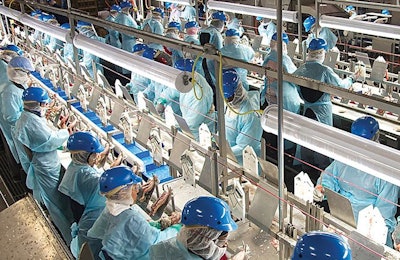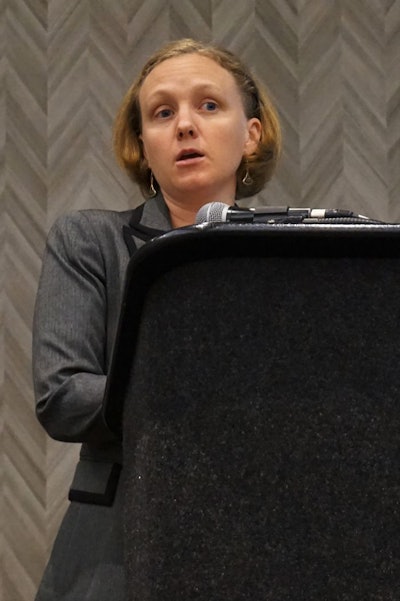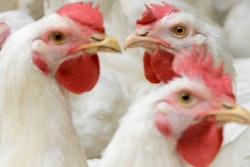
Peracetic acid (PAA) is widely used in poultry plants, but a lack of reliable technology to measure its concentration in the atmosphere makes it difficult for regulators and plant operators to accurately measure the airborne chemical in the plant so worker exposure can be accurately calculated.
What is peracetic acid
Peracetic acid is a disinfectant chemical used widely in industrial sectors as varied as food and beverage, health care, water purification and cosmetics.
In a presentation given as part of the 2019 Poultry Processor Workshop in Nashville, Tennessee, Paul Bredwell, the U.S. Poultry & Egg Association’s (USPOULTRY) vice president of environmental programs, said the chemical is widely used in poultry processing because of its effectiveness. It’s used in scalders, chillers, dip tanks, belt washers, sprays, the sanitization of carcasses, organs and parts, as well as plant clean up.

Paul Bredwell, U.S. Poultry & Egg Association | Photo by Austin Alonzo
In a statement, Dr. Kevin H. Dunn, research mechanical engineer at the Centers for Disease Control’s National Institute for Occupational Safety and Health (NIOSH) Division of Field Studies and Engineering, said PAA is a colorless liquid with a characteristic acrid odor reminiscent of acetic acid, a component of vinegar. It can be highly corrosive. PAA is always sold in solution as a mixture with acetic acid and hydrogen peroxide to maintain its stability. The concentration of the acid as the active ingredient can vary.
Dunn said acute exposure to PAA has been shown to cause irritation of the eyes, skin and upper respiratory tract. A NIOSH study published in 2018 found that workers reported watery eyes, nasal irritation, asthma-like symptoms and shortness of breath when using a disinfectant containing PAA in a hospital.
Over time, PAA does break down so it, and its constituents, are not present on the final food products. Therefore, the chemical is not a risk to food safety or consumer health.
What is a safe exposure level for airborne PAA in the workplace?
PAA does not have an established occupational exposure limit set by the Occupational Safety and Health Administration (OSHA) or NIOSH, according to Dunn. However, a non-governmental agency, the American Conference of Governmental Industrial Hygienists maintains short term exposure limit of 0.4 parts per million (ppm) for PAA measured as an inhalable fraction and vapor over a 15 minute period.
Another key occupational exposure limit, which is not yet binding but is part of the conversation surrounding PAA is the State of California’s Division of Occupational Safety and Health, known as Cal/OSHA, is consideration of a short term PAA exposure limit (of at least 15 minutes) of 0.4 ppm and an 8-hour permissible exposure limit of 0.15 ppm. Cal/OSHA did not respond to a request for comment on the current state of this proposed limit.

Georgia Tech researchers wore the ChemDAQ SafeCide Portable Air Monitor, the ATI D16 PortaSens III Portable Gas Leak Detector and the Interscan 4000 Series Compact Portable Analyzer simultaneously to test peracetic acid levels in poultry plants. | Courtesy Bob Hendry, Georgia Tech
Studying levels of PAA in poultry plants
In the past two years, USPOULTRY funded studies monitoring the amount of PAA present in the environment of poultry plants and potential levels of exposure to workers. Jenny Houlroyd, a senior research scientist at the Georgia Institute of Technology (Georgia Tech), worked on two studies. The first examined the amount of PAA present in the environment of poultry plants and the second compared the performance of sensors monitoring the environmental presence of the chemical near plant workers.

Jenny Houlroyd, Georgia Institute of Technology | Photo by Austin Alonzo
In an interview, she said the first study found that the chemical was present in the environment of poultry plants. If they were adopted, the study found, most poultry plants would have areas within their plants exceeding the proposed Cal/OSHA 8-hour time weighted average exposure limit.
Dr. Ashley Peterson, senior vice president of scientific and regulatory affairs for the National Chicken Council (NCC) said, though the majority of PAA used in the processing plant is in the highly-automated first processing portion of the plant, the industry is committed to mitigating exposure in any area of the establishment.
The second study compared the performance of a number of commercial available sensor instruments with the performance of the existing, laboratory-based method for sampling for PAA. The research trials showed the devices are not effective at delivering consistent, accurate and precise results in the poultry plant environment.
Houlroyd said the study showed that at any given moment all the different sampling methods would give disparate results. For example, during one day of testing values of PAA detected by the various sensors at a single site ranged from .07 ppm to .56 ppm. Some sensors and testing methods did show some similarity in results when they were tested as close as one foot away from the source of PAA, but that relationship disappeared once the distance increased to three feet.
“What we are trying to really say is that these technologies may work in other environments but in environments where there’s potential for exposure to chlorine, or high humidity, they may not be as accurate,” Houlroyd said. “It’s frustrating from both the perspective of the worker – because there are (U.S. Department of Agriculture) inspectors that are reporting that they are experiencing symptoms – but then it’s also frustrating for an employer at a poultry plant that’s trying to do the right thing and doesn’t know what is their baseline, and what to shoot for, and if the measurements they are taking are accurate.”
The potential next steps
Houlroyd said she isn’t presently working on any more studies on PAA. Nevertheless, USPOULTRY remains committed to funding studies of the use of the substance, Bredwell said in Nashville. Houlroyd said pausing on further studies is necessary for now because NIOSH is conducting its own study of the chemical.
“NIOSH is studying PAA and is planning studies in order to gain a better understanding of exposures in the workplace and how to reduce them,” Dunn said in a statement. “This work is still in its preliminary stages, so we are not able to provide more information about that work at this time.”
In the past, NIOSH published three studies on PAA exposure. Two of which published in 2014 and 2015, respectively, focused on the assessment and evaluation of PAA exposure among federal poultry inspectors.
Dunn did not comment on what role NIOSH’s work would play in any potential OSHA-mandated regulation of the use of the chemical. The poultry industry is presently working with OSHA on PAA as well as other key processing related topics.
Houlroyd did say the process for OSHA to set a new limit is lengthy and requires much research as well as proof that any regulation would not harm the financial viability of the industry itself in addition to protecting worker health.
There is, though, development of new testing methods which may work better for the processing plant environment. Currently, an impinger device made of glass is the best method for detection. If a plastic impinger, Houlroyd said, was ever developed that would work much better in a poultry plant than a fragile glass device. Furthermore, the manufacturers of the PAA sensors are making improvements to their current designs based on the feedback of the academics studying the issue.
Houlroyd said accurate devices and clear standards are needed so all players can know what they are doing right and what they are doing wrong. Not having a consistently accurate way to measure PAA, and therefore influence appropriate exposure guidelines, is hard on employers who are trying to do the right thing.
In a statement, the NCC – the Washington-based industry group representing broiler producers – said food safety and the safety of employees and federal inspectors are top priorities for the industry.
“Even though there may not be an established federal exposure limit for PAA, the industry is making great strides to ensure a safe working environment for our team members. The industry is working very closely with PAA manufacturers, industrial hygienists, and engineers to implement best practices as it relates to PAA handling, storage, and use,” the statement said. “The industry needs an accurate testing method for PAA where readings are not influenced by other variables in the processing plant. That is why we strongly support the work being funded by USPOULTRY and the research being performed by (Georgia Tech).”


















